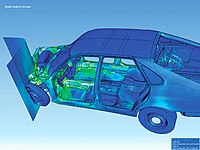
Photo from wikipedia
Although the concept modeling method has already been proposed in the literature, there is still very limited knowledge about the validation and the application of this method for vehicle body… Click to show full abstract
Although the concept modeling method has already been proposed in the literature, there is still very limited knowledge about the validation and the application of this method for vehicle body design. This paper substantially increases this limited knowledge by developing a concept model for predicting and optimizing the structural dynamics of a vehicle body-in-white and validating this concept model against a detailed finite element model. The geometry and parameters of the concept model are extracted from its detailed finite element model. The major members and panels of the detailed finite element model are replaced by their equivalent beam and shell elements models. The joints of the concept model are represented by stiffness and mass matrices extracted from the detailed finite element model using the Guyan Reduction Method. The developed concept model is validated by comparing its structural dynamics, including the resonant frequencies and the vibration mode shapes, with the original detailed finite element model and the experimental results. The simplicity and small size of the concept model enable it to easily enhance the structural dynamics of the body-in-white by optimizing the cross-sections of the load-carrying members of the structure. The optimization in this case increased the resonant frequencies of the body-in-white while reducing the total mass by about 6 kg. The results prove that the concept modeling method can significantly enhance the body-in-white structural dynamics by reducing the complexity of the model and allowing the focus for the optimization to be on the main members of the structure at the development stage when the final design parameters are not well known and have not been fixed.
Journal Title: Proceedings of the Institution of Mechanical Engineers, Part D: Journal of Automobile Engineering
Year Published: 2020
Link to full text (if available)
Share on Social Media: Sign Up to like & get
recommendations!